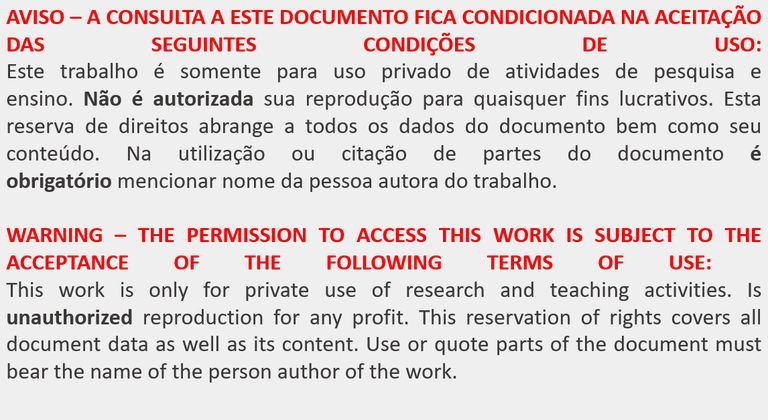2022 - Clara Beatriz de Lima
MSc. Thesis
Autor/author: Clara Beatriz de Lima
Programa de Pós-Graduação em Ciências Farmacêuticas - Universidade Estadual de Maringá
Data de Defesa: 30 de setembro de 2022
Orientador: Prof. Dr. João Carlos Palazzo de Mello
Banca examinadora: Profa. Dra. Danielle Lazarin Bidóia
Profa. Dra. Renata Longhini Veríssimo
Título: Avaliação in vitro do potencial fotoprotetor de extratos das flores de Pyrostegia venusta.
Resumo: A radiação ultravioleta (UV) é dividida em: UVA, UVB e UVC, sendo a UVB a mais intensa podendo causar queimadura solares graves, além da formação de espécies reativas de oxigênio (EROs) que provocam danos celulares e ao DNA. As espécies reativas geradas pela exposição aos raios UV podem ser neutralizadas por substâncias antioxidantes, prevenindo, reduzindo ou reparando o dano induzido. Substâncias que tem o objetivo de combater a EROs e devido à grande busca de substâncias de origem natural, a Pyrostegia venusta, Bignoniaceae, popularmente conhecida como flor de São João, seria uma alternativa. Essa espécie é encontrada em várias regiões do Brasil e suas flores, folhas, caules e raízes são utilizados popularmente para tratamento de diversas doenças. Os metabólitos presentes nessa espécie podem possuir a capacidade de fotoproteção. Assim, o objetivo deste trabalho foi avaliar in vitro, a capacidade fotoprotetora de diferentes extratos e frações das flores de P. venusta. As técnicas utilizadas foram: avaliação antioxidante, e viabilidade celular em fibroblastos L929 irradiado com UVB, geração de EROs e ensaio de migração celular em fibroblastos L929 (cicatrização de ferida). Os resultados demonstraram que os extratos e frações das flores P. venusta possuem atividade antioxidante, principalmente a fração acetato de etila:n-butanol (6:1) que se destacou nos ensaios antioxidantes de DPPH e XO. Com a metodologia validada por cromatografia líquida de alta eficiência foi possível verificar a separação das substâncias majoritárias, acteosídeo e β-OH-acteosídeo, nos extratos e frações. Além disso, foi possível determinar do teor dessas substâncias, nas frações AcEt:n-But (6:1), (3:1) e (1:1), no extrato bruto (EB) e no EB com 10% da fração AcEt:n-But (6:1). Essas amostras apresentaram teor de acteosídeo + β-OH-acteosídeo (Act+ β-OH-Act) de 50,02; 34,68; 28,44; 8,12 e 13,34%, respectivamente. As frações não apresentaram citotoxicidade em fibroblastos L929, abaixo de 50 µg/mL, exceto a fração (6:1) em concentração abaixo de 25 µg/mL e, os extratos não apresentaram citotoxicidade em concentrações abaixo de 200 µg/mL. Foi possível confirmar que a fração AcEt:n-But (6:1), o Act+ β-OH-Act e o EB, protegeram as linhagem celular L929 frente aos raios UVB, bem como diminuíram as EROs geradas. Na técnica de migração celular foi observado que, nas concentrações utilizadas da fração AcEt:n-But (6:1) e do Act+ β-OH- Act não houve crescimento significativo em relação ao controle, demonstrando que a amostra não apresentou capacidade em regenerar a ferida artificial. Com os resultados obtidos pode-se afirmar que a fração AcEt:n-But (6:1) e a substância isolada apresentam potencial para proteção solar.
Palavras-chave: Fotoproteção; antioxidantes; UVB; Bignoniaceae.
Title: In vitro evaluation of the photoprotective potential of extracts from the flowers of Pyrostegia venusta.
Abstract: Ultraviolet radiation (UV) is divided into: UVA, UVB and UVC, with UVB being the most intense, which can cause severe sunburn, in addition to the formation of reactive oxygen species (ROS) that cause cell and DNA damage. The reactive species generated by exposure to UV rays can be neutralized by antioxidant substances, preventing, reducing or repairing the induced damage. Substances that aim to combat ROS and due to the great search for substances of natural origin, Pyrostegia venusta, Bignoniaceae, popularly known as “São João flower”, would be an alternative. This species is found in several regions of Brazil and its flowers, leaves, stems and roots are popularly used to treat various diseases. The metabolites present in this species may have photoprotective capacity. Thus, the objective of this work was to evaluate, in vitro, the photoprotective capacity of different extracts and fractions of P. venusta flowers. The techniques used were: antioxidant evaluation, and cell viability in L929 fibroblasts irradiated with UVB, generation of ROS and cell migration assay in L929 fibroblasts (wound healing). The results showed that the extracts and fractions of the P. venusta flowers have antioxidant activity, especially the ethyl acetate:n-butanol (6:1) fraction, which stood out in the antioxidant assays of DPPH and XO. With the methodology validated by high performance liquid chromatography, it was possible to verify the separation of the major substances, acteoside and β-OH-acteoside, in the extracts and fractions. Furthermore, it was possible to determine the content of these substances in the AcEt:n-But fractions (6:1), (3:1) and (1:1), in the crude extract (EB) and in the EB with 10% of the fraction AcEt:n-But (6:1). These samples had an acteoside + β-OH-acteoside (Act+ β-OH-Act) content of 50.02; 34.68; 28.44; 8.12 and 13.34%, respectively. The fractions did not show cytotoxicity in L929 fibroblasts, below 50 µg/mL, except for the fraction (6:1) in concentrations below 25 µg/mL, and the extracts did not show cytotoxicity in concentrations below 200 µg/mL. It was possible to confirm that the AcEt:n- But fraction (6:1), the Act+ β-OH-Act and the EB, protected the L929 cell line against UVB rays, as well as decreased the generated ROS. In the cell migration technique, it was observed that, in the concentrations used of the AcEt:n-But fraction (6:1) and of the Act+ β-OH-Act, there was no significant growth in relation to the control, demonstrating that the sample did not have the ability to regenerate the artificial wound. With the results obtained, it can be stated that the AcEt:n-But fraction (6:1) and the isolated substance have potential for sun protection.
Keywords: Photoprotection; antioxidants; UVB; Bignoniaceae.
Dissertação PDF: clique aqui

